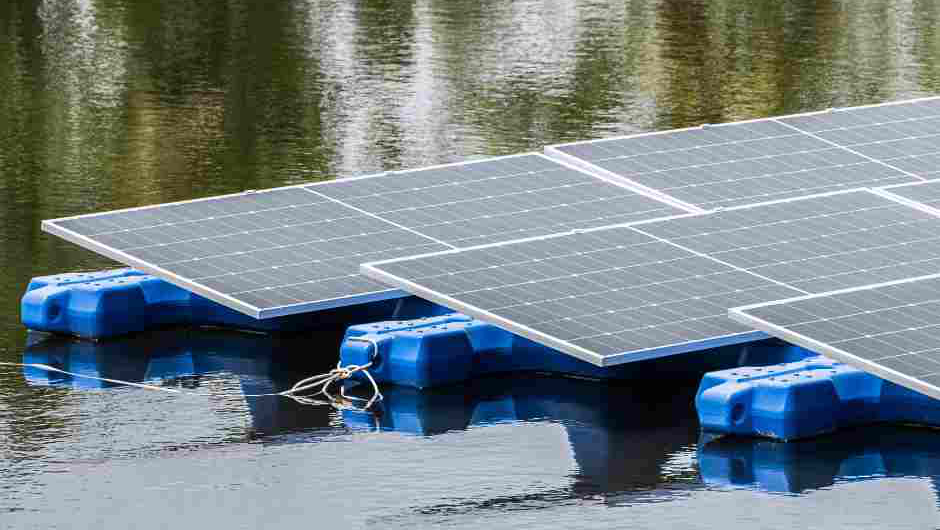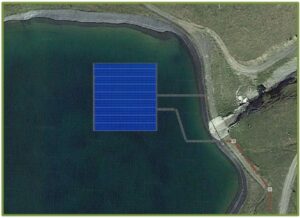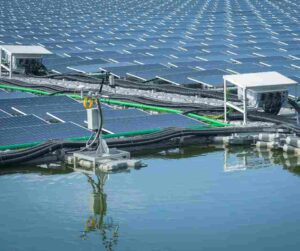Reading time: 2 minutes
Design project for a floating photovoltaic installation on the snowmaking pond of Espot Esquí

En el marc del projecte PSTD Bike Natura-Aventura, impulsat pel Consell Comarcal del Pallars Sobirà i cofinançat a través dels fons europeus Next Generation EU, hem desenvolupat el disseny tècnic d’una instal·lació fotovoltaica flotant per autoconsum sobre la bassa d’innivació “Els Estanyets”, ubicada dins el recinte de l’estació d’Espot Esquí, a 2.120 metres d’altitud.
Aquesta proposta s’inclou dins l’actuació 5 “Fotovoltaica flotant pistes d’esquí”, en el marc de l’eix 2 “Millora de l’eficiència energètica” del Pla de Sostenibilitat Turística en Destinacions (PSTD). L’objectiu és promoure noves solucions energètiques sostenibles en entorns d’alta muntanya, aprofitant infraestructures existents i reduint la petjada ambiental de les instal·lacions turístiques hivernals.
Advantages of floating photovoltaics in high mountain environments
The installation of photovoltaic fields on water surfaces offers various technical and environmental advantages:

• Optimization of land use, especially in protected natural environments where landscape and territorial impact is critical.
• Improvement in solar panel efficiency due to the cooling effect of the water, which reduces operating temperature and increases electrical performance.
• Reduction of water evaporation from the pond and limitation of algae growth.
• Functional integration with existing infrastructures, such as snowmaking ponds.
These types of installations are especially relevant in the current context, where, after a prolonged period of drought, recent rains have allowed the recovery of water reserves in many reservoirs and ponds across the country.
This scenario reinforces the need to propose complementary and sustainable uses of these water resources, such as renewable electricity generation with zero direct emissions.
The project foresees the installation of rows of horizontal photovoltaic modules, placed on a floating structure specifically designed for extreme snow and wind conditions. Although they may be subject to change, the following preliminary points have been defined:
- Minimum available pond area
- Floating structure capable of supporting the snow loads at this altitude, with an associated maintenance protocol to ensure the correct operation of the installation. South orientation and placement of the solar field in the area with the most sunlight, minimizing shadows.
- High-efficiency monocrystalline (mono-PERC) photovoltaic modules with a product warranty of ≥ 15 years.
- Inverters with multiple MPPTs to optimize energy capture.
- Voltage drop < 3%, with wiring designed to adapt to the varying water levels of the pond.
- Technical and access walkways integrated into the floating island itself to facilitate maintenance.
- Flexible anchoring with adjustable tensioners to adapt to water level changes.
- Provision of a technical room to house inverters and electrical protection equipment
Characteristics of the floating structure
 The support structure is based on panel floaters made of HDPE (high-density polyethylene) with UV protection, which provide a fixed inclination of 15º for the modules. Each module rests on three floaters, ensuring a buoyancy of 66 kg/m² and a separation that allows natural panel ventilation.
The support structure is based on panel floaters made of HDPE (high-density polyethylene) with UV protection, which provide a fixed inclination of 15º for the modules. Each module rests on three floaters, ensuring a buoyancy of 66 kg/m² and a separation that allows natural panel ventilation.
Additionally, the design includes maintenance floaters with a rough anti-slip surface to allow safe movement of technical personnel, as well as a walkway from the edge of the pond to the central floating island.
This project exemplifies the potential of floating photovoltaics as an innovative and replicable solution, particularly in high mountain areas where environmental compatibility is key. The design addresses both structural and operational requirements, ensuring a safe, efficient, and integrated installation within the environment.
As water resources recover, and in the context of the urgent energy transition, it is essential to leverage synergies between energy and territory to generate added value and move towards more intelligent and sustainable resource management.